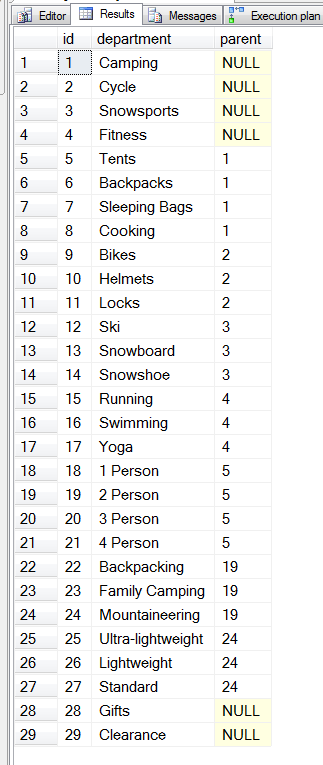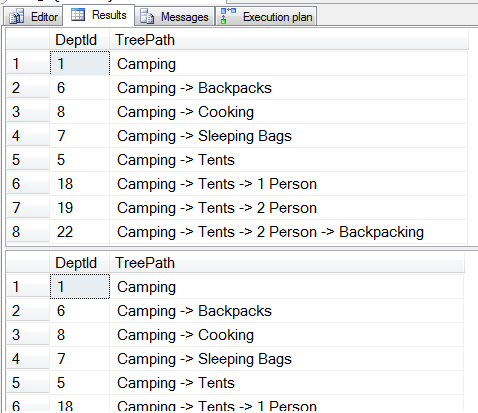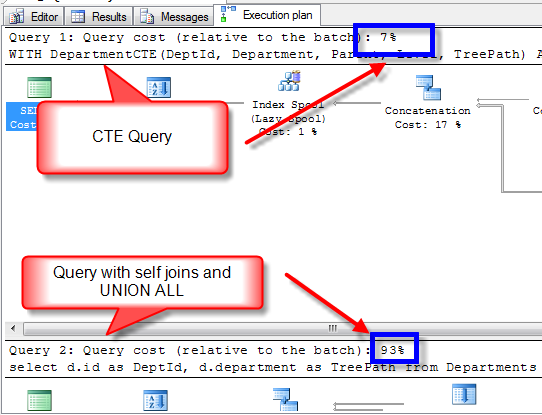After my CTE presentation a while back I was asked many questions, and received several great suggestions from people.
One question was how does the performance compare between a recursive CTE to generate a hierarchical tree path listing and a query using self JOINs and UNION ALL to generate similar results. To test this I created a simple table for departments in an online store that contained the following rows.
Then I wrote two queries to generate a tree path for all departments in the list.
First the CTE Query:
-- Performance Differences
-- Remember Ctrl+M to turn on Execution Plan
-- Recursive CTE compared to Multiple Self Joins
;WITH departmentcte(deptid, department, parent, LEVEL, treepath) AS
( SELECT id AS deptid, department, parent, 0 AS LEVEL,
CAST(department AS VARCHAR(1024)) AS treepath
FROM departments
WHERE parent IS NULL
UNION ALL -- and now for the recursive part
SELECT d.id AS deptid, d.department, d.parent,
departmentcte.LEVEL + 1 AS LEVEL,
CAST(departmentcte.treepath + ' -> ' +
CAST(d.department AS VARCHAR(1024))
AS VARCHAR(1024)) AS treepath
FROM departments d
INNER JOIN departmentcte
ON departmentcte.deptid = d.parent
)
SELECT deptid, treepath
FROM departmentcte
ORDER BY treepath;
Then the Non CTE Query (ugly):
-- Multiple Self Joins Unioned
-- Difficult to display Parent categories
SELECT d.id AS deptid, d.department AS treepath
FROM departments d
WHERE d.parent IS NULL
UNION ALL
SELECT da2.id AS deptid,
da1.department + ' -> ' +
da2.department AS treepath
FROM departments da1
INNER JOIN departments da2 ON da1.id = da2.parent
WHERE da1.parent IS NULL
UNION ALL
SELECT db3.id AS deptid,
db1.department + ' -> ' +
db2.department + ' -> ' +
db3.department AS treepath
FROM departments db1
INNER JOIN departments db2 ON db1.id = db2.parent
INNER JOIN departments db3 ON db2.id = db3.parent
WHERE db1.parent IS NULL
UNION ALL
SELECT dc3.id AS deptid,
dc1.department + ' -> ' +
dc2.department + ' -> ' +
dc3.department + ' -> ' +
dc4.department AS treepath
FROM departments dc1
INNER JOIN departments dc2 ON dc1.id = dc2.parent
INNER JOIN departments dc3 ON dc2.id = dc3.parent
INNER JOIN departments dc4 ON dc3.id = dc4.parent
WHERE dc1.parent IS NULL
UNION ALL
SELECT dd3.id AS deptid,
dd1.department + ' -> ' +
dd2.department + ' -> ' +
dd3.department + ' -> ' +
dd4.department + ' -> ' + dd5.department AS treepath
FROM departments dd1
INNER JOIN departments dd2 ON dd1.id = dd2.parent
INNER JOIN departments dd3 ON dd2.id = dd3.parent
INNER JOIN departments dd4 ON dd3.id = dd4.parent
INNER JOIN departments dd5 ON dd4.id = dd5.parent
WHERE dd1.parent IS NULL
ORDER BY treepath
;
The two queries were confirmed to produce the same results:
But when looking at the actual execution plan for the queries, there is a very big difference. The self JOIN, and UNION ALL query took 13 times as long to run as the CTE query did.
Results:
The CTE compared to the self JOIN with UNION ALL is a double win, first the CTE is much easier to read, second the CTE is much faster with 1/13th of the time it took to execute the self JOIN, UNION ALL solution. Also in the examples shown we showed the queries were used to show up to 5 levels of categories. If we wanted to go further than 5 levels, the difference gets even worse between the CTE and the self JOIN, UNION ALL solution.
More from Stedman Solutions:

Steve and the team at Stedman Solutions are here for all your SQL Server needs.
Contact us today for your free 30 minute consultation..
We are ready to help!





First, I very much appreciate anyone that steps up to the plate to write an article about something in SQL Server. Thanks for all your articles.
You might want to grow the test data bit and then test for reads, writes, CPU, and duration because % of Batch is seriously unreliable when it comes to determining which of two pieces of code is the most performant. It can easily be entirely backwards where the worst performing query has a % of Batch = 0 and the best performing query has a % of Batch = 100%. That’s also a typical fault with recursive CTEs.
I don’t know if that’s the case here because I don’t see any code in the article that actually generates the loaded test table and so cannot conduct the same test you did.